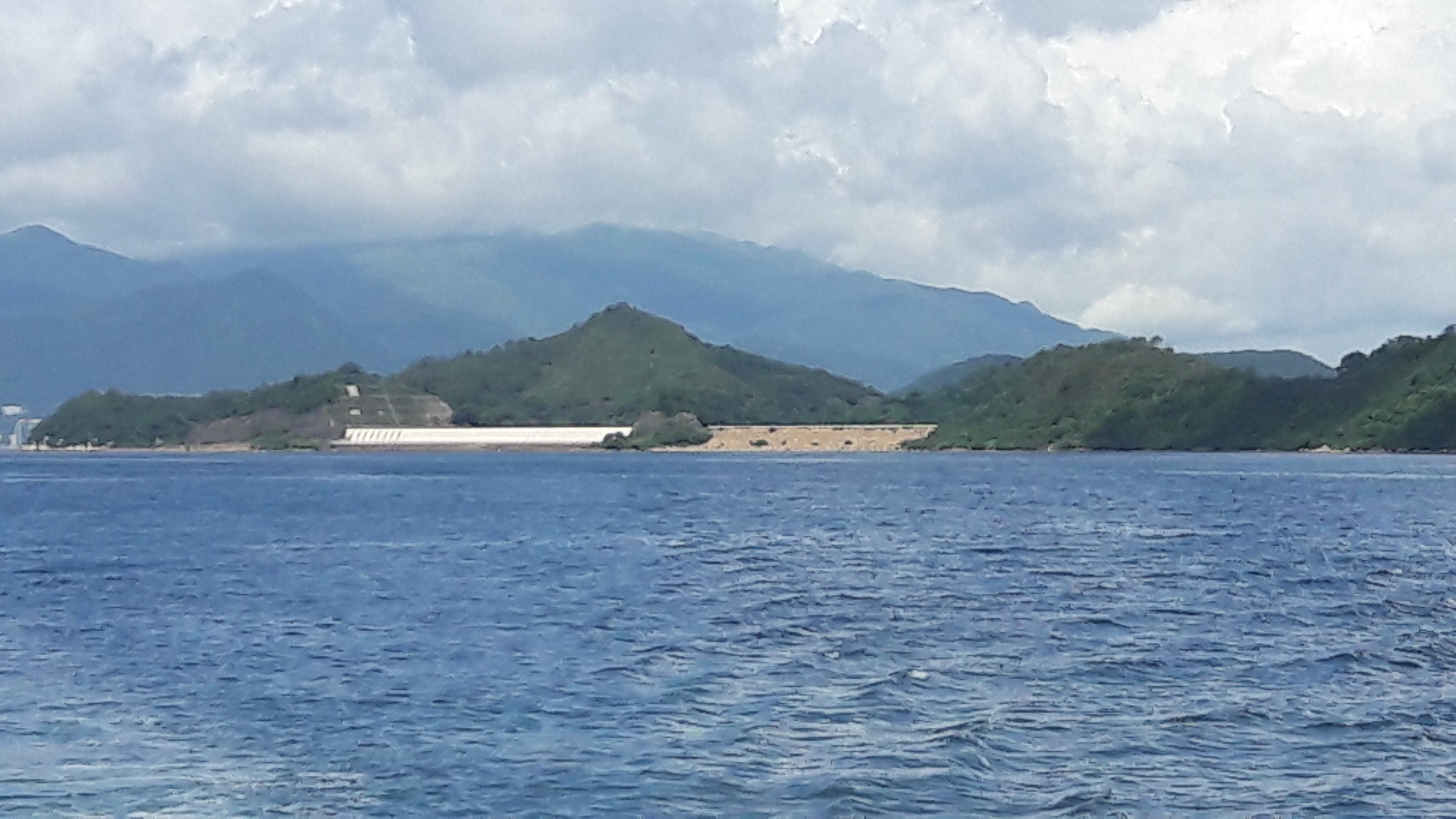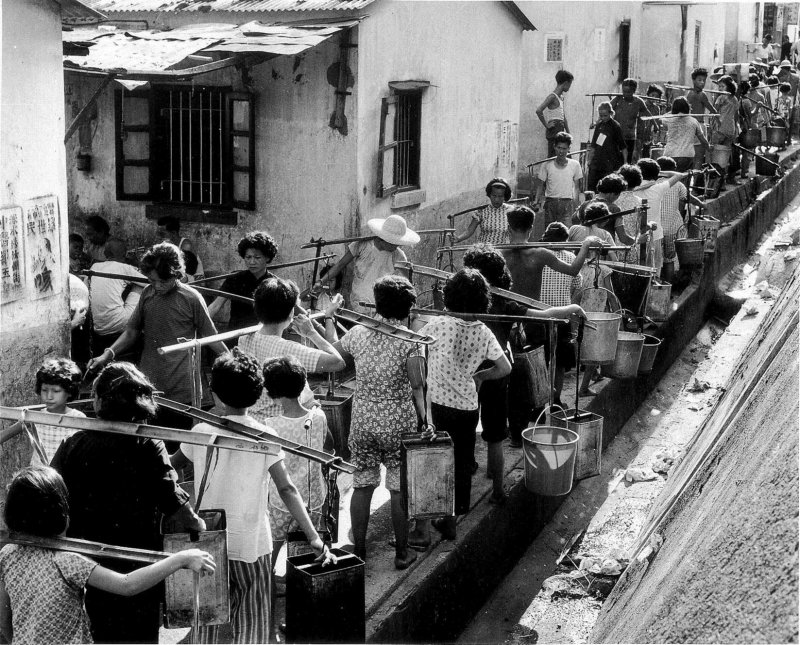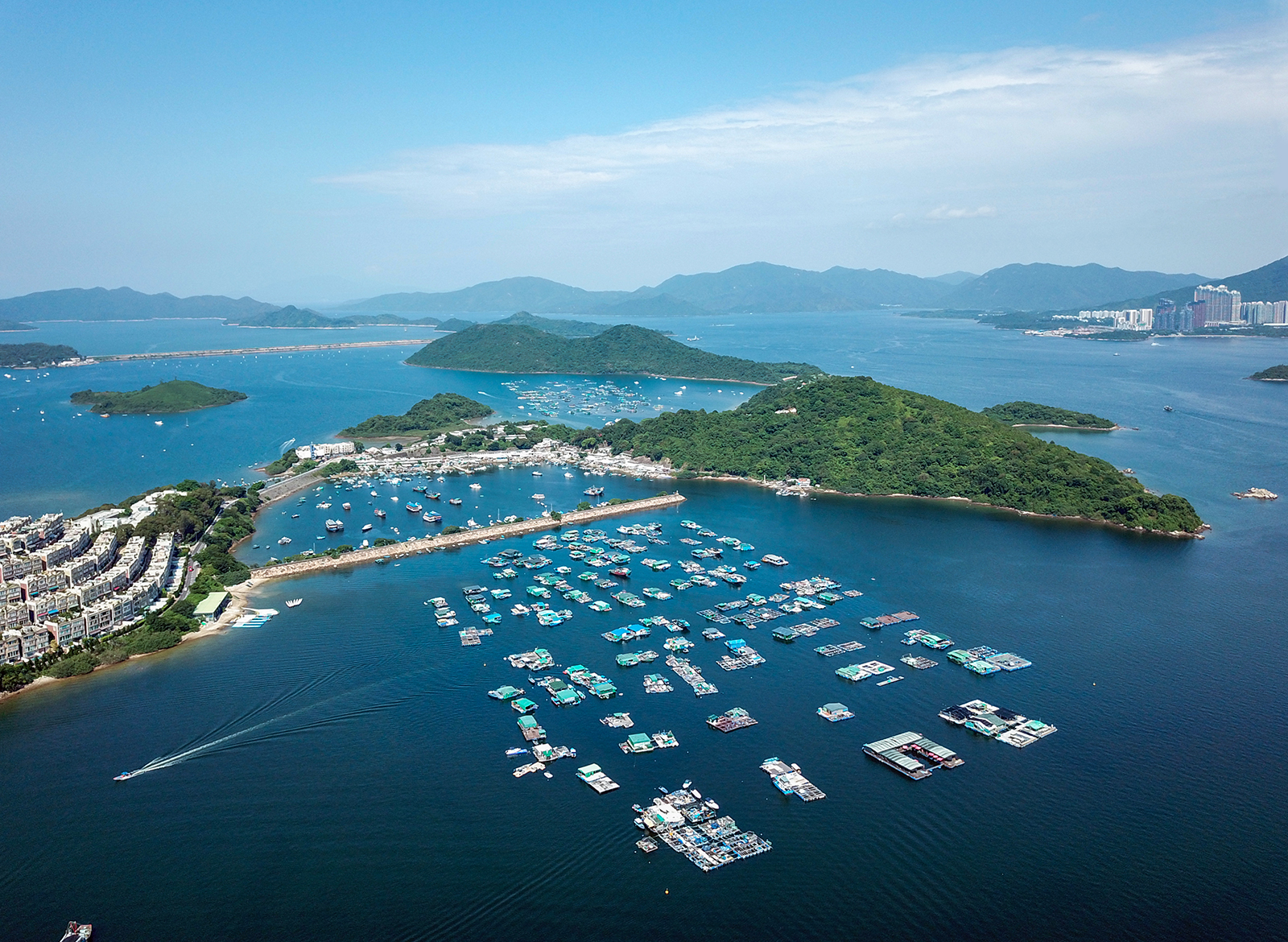|
Plover Cove Reservoir
Plover Cove Reservoir, located within Plover Cove Country Park, in the northeastern New Territories, is the largest reservoir in Hong Kong in terms of area, and the second-largest in terms of volume. It is the world's first freshwater coastal lake constructed from an arm of the ocean. Its main dam, which disconnected Plover Cove from the sea, was one of the largest in the world at the time of its construction. History Planning Hong Kong lacks significant natural inland water bodies, and providing water supply to the territory's population has long been fraught with problems. On 24 July 1958, it was disclosed by a government spokesman that government engineers were studying the idea of converting sea inlets into freshwater lakes, and cited Plover Cove as one of the foremost areas under consideration. The plan was considered feasible as the cove was mostly enclosed on three sides, and could be fully cut off from the sea by damming sections of the Tolo Harbour known to be very ... [...More Info...] [...Related Items...] OR: [Wikipedia] [Google] [Baidu] |
New Territories
The New Territories is one of the three main regions of Hong Kong, alongside Hong Kong Island and the Kowloon Peninsula. It makes up 86.2% of Hong Kong's territory, and contains around half of the population of Hong Kong. Historically, it is the region described in the Convention for the Extension of Hong Kong Territory. According to that treaty, the territories comprise the mainland area north of Boundary Street on the Kowloon Peninsula and south of the Sham Chun River (which is the border between Hong Kong and Mainland China), as well as over 200 outlying islands, including Lantau Island, Lamma Island, Cheung Chau, and Peng Chau in the territory of HK. Later, after New Kowloon was defined from the area between the Boundary Street and the Kowloon Ranges spanned from Lai Chi Kok to Lei Yue Mun, and the extension of the urban areas of Kowloon, New Kowloon was gradually urbanised and absorbed into Kowloon. The New Territories now comprises only the mainland north of th ... [...More Info...] [...Related Items...] OR: [Wikipedia] [Google] [Baidu] |
Tai Po
Tai Po is an area in the New Territories of Hong Kong. It refers to the vicinity of the traditional market towns in the area presently known as Tai Po Old Market or Tai Po Kau Hui () (the original "Tai Po Market") on the north of Lam Tsuen River and the Tai Po Hui (the current Tai Po Market; historically Tai Wo Shi, literally ''Tai Wo market'') on Fu Shin Street on the south of the Lam Tsuen River, near the old Tai Po Market railway station of the Kowloon-Canton Railway (British Section). Both market towns became part of the Tai Po New Town in the late 1970s and early 1980s. In present-day usage, "Tai Po" may refer to the area around the original market towns, the Tai Po New Town (), or the entire Tai Po District. Etymology In Chinese, the place, Tai Po (), was formerly written as . Treating the Chinese characters separately, the pronounce of Po in the third tone () in Cantonese are shared with many words, not only Po in the sixth tone (). For example, the "Po" () of Sha ... [...More Info...] [...Related Items...] OR: [Wikipedia] [Google] [Baidu] |
Traditional Chinese Character
Traditional Chinese characters are one type of standard Chinese character sets of the contemporary written Chinese. The traditional characters had taken shapes since the clerical change and mostly remained in the same structure they took at the introduction of the regular script in the 2nd century. Over the following centuries, traditional characters were regarded as the standard form of printed Chinese characters or literary Chinese throughout the Sinosphere until the middle of the 20th century, before different script reforms initiated by countries using Chinese characters as a writing system. Traditional Chinese characters remain in common use in Taiwan, Hong Kong and Macau, as well as in most overseas Chinese communities outside Southeast Asia; in addition, Hanja in Korean language remains virtually identical to traditional characters, which is still used to a certain extent in South Korea, despite differing standards used among these countries over some variant Chines ... [...More Info...] [...Related Items...] OR: [Wikipedia] [Google] [Baidu] |
Royal Asiatic Society Hong Kong Branch
Royal Asiatic Society Hong Kong Branch is an organisation to encourage interest in Asia broadly, with an emphasis on Hong Kong. The society was founded in 1847 and folded 1859. It was revived on December 28, 1959. Its parent association is the Royal Asiatic Society of Great Britain and Ireland. The Society is open to all with an interest in the art, literature and culture of China and Asia, with special reference to Hong Kong. History In 1847 the Hong Kong branch of the Royal Asiatic Society was founded under its parent society, the Asiatic Society of Great Britain and Ireland. The latter had in turn been founded in 1823 by Sir Henry Thomas Colebrooke and others. In 1824 the Asiatic Society received a Royal Charter from patron King George IV and was charged with ‘the investigation of subjects connected with and for the encouragement of science, literature and the arts in relation to Asia.’ In around 1838, branches were formed in Mumbai and Chennai, and Sri Lanka in 1845. The H ... [...More Info...] [...Related Items...] OR: [Wikipedia] [Google] [Baidu] |
Water Supply And Sanitation In Hong Kong
Water supply and sanitation in Hong Kong is characterised by water import, reservoirs and treatment infrastructure. Though multiple measures were made throughout its history, providing an adequate water supply for Hong Kong has met with numerous challenges because the region has few natural lakes and rivers, inadequate groundwater sources (inaccessible in most cases due to the hard granite bedrock found in most areas in the territory), a high population density, and extreme seasonable variations in rainfall. Thus nearly 80 percent of water demand is met by importing water from mainland China, based on a longstanding contract. In addition, freshwater demand is curtailed by the use of seawater for toilet flushing, using a separate distribution system. Hong Kong also uses reservoirs and water treatment plants to maintain its source of clean water. History Water rationing Until 1964 water rationing - the act of limiting water usage for each households by water providers - was a con ... [...More Info...] [...Related Items...] OR: [Wikipedia] [Google] [Baidu] |
Scott Wilson Group
Scott Wilson Group plc was a global integrated design and engineering consultancy with its headquarters in the United Kingdom. Founded as a civil engineering firm in 1951, the company broadened its range of services through acquisitions. Scott Wilson offered consultancy and professional services in the railways, buildings and infrastructure, environment and natural resources and roads sectors, and at its peak employed 5,500 people in 80 offices worldwide. Scott Wilson became a public limited company in 2006, and in 2010 was purchased by URS Corporation that in turn was purchased by AECOM. History Sir Cyril Kirkpatrick (1872–1957) was Chief Engineer to the Port of London Authority from 1913 to 1924, when he established his own firm specialising in docks, harbours and sea defences. During World War II, Kirkpatrick advised on the construction of the concrete caissons which formed the Mulberry Harbour that facilitated the D-Day landings. In 1945 engineers William Scott and Dr ... [...More Info...] [...Related Items...] OR: [Wikipedia] [Google] [Baidu] |
List Of Reservoirs Of Hong Kong
Reservoirs in Hong Kong are spread fairly evenly over the entire 1,104 km² of Hong Kong. There is plenty of space for small reservoirs in Hong Kong, as the hilly areas provide valleys suitable for water storage. However, the larger reservoirs, i.e. High Island Reservoir and Plover Cove Reservoir, were built differently. Dams were built where the reservoir's edge was proposed to be, sea water was drained out and replaced with fresh water. Drinking-water reservoirs New Territories *High Island Reservoir () *Plover Cove Reservoir () *Shing Mun Reservoirs () ** Shing Mun (Jubilee) Reservoir () **Lower Shing Mun Reservoir () *Tai Lam Chung Reservoir () Kowloon *Kowloon Group of Reservoirs () **Kowloon Reservoir () ** Kowloon Byewash Reservoir () **Kowloon Reception Reservoir () **Shek Lei Pui Reservoir () Hong Kong Island * Aberdeen Reservoirs () ** Aberdeen Upper Reservoir () ** Aberdeen Lower Reservoir () *Pok Fu Lam Reservoir () *Tai Tam Reservoirs () **Tai Tam Up ... [...More Info...] [...Related Items...] OR: [Wikipedia] [Google] [Baidu] |
Conservation In Hong Kong
Out of the total 1,092 km2 of Hong Kong land, three-quarters is countryside, with various landscapes including beaches, woodlands, and mountain ranges being found within the small territory. Most of Hong Kong's parks have abundant natural diversity, usually containing over 1,000 species of plants. Country parks To conserve and, where appropriate, open up the countryside for the greater enjoyment of the population, the Country Parks Ordinance was enacted in 1976 to provide a legal framework for the designation, development, and management of Country Parks and Special Areas. It provides for establishing a Country and Marine Parks Board to advise the Director of Agriculture, Fisheries, and Conservation, who, like the Country and Marine Parks Authority, is responsible for all matters on Country Parks and Special Areas. A total of 24 country parks have been designated. The country parks and special areas cover a total area of 440 km2. Country Parks are designated for the purposes ... [...More Info...] [...Related Items...] OR: [Wikipedia] [Google] [Baidu] |
Barbecue
Barbecue or barbeque (informally BBQ in the UK, US, and Canada, barbie in Australia and braai in South Africa) is a term used with significant regional and national variations to describe various cooking methods that use live fire and smoke to cook the food. The term is also generally applied to the devices associated with those methods, the broader cuisines that these methods produce, and the meals or gatherings at which this style of food is cooked and served. The cooking methods associated with barbecuing vary significantly but most involve outdoor cooking. The various regional variations of barbecue can be broadly categorized into those methods which use direct and those which use indirect heating. Indirect barbecues are associated with North American cuisine, in which meat is heated by roasting or smoking over wood or charcoal. These methods of barbecue involve cooking using smoke at low temperatures and long cooking times, for several hours. Elsewhere, barbecuing more co ... [...More Info...] [...Related Items...] OR: [Wikipedia] [Google] [Baidu] |
Tai Mei Tuk
Tai Mei Tuk (officially known as in Chinese; formerly and still commonly known as ; also written as or ) is a place close to the Plover Cove Reservoir in the Tai Po District, New Territories, Hong Kong. Administration Tai Mei Tuk is a recognized village under the New Territories Small House Policy. It is one of the villages represented within the Tai Po Rural Committee. For electoral purposes, Tai Mei Tuk is part of the Shuen Wan constituency, which was formerly represented by So Tat-leung until October 2021. History Historically, Ting Kok, together with the nearby Hakka villages of Shan Liu, Lai Pik Shan, Lo Tsz Tin, Lung Mei and Tai Mei Tuk belonged to the Ting Kok Yeuk () alliance. Name Tai Mei Tuk means "the very end" in the Cantonese language which depicts the landscape. The homonym character (tuk) is borrowed for the name. Recent Cantonese research suggested that the correct character is . Features Tai Mei Tuk is a popular place for barbecues and cycling. There ar ... [...More Info...] [...Related Items...] OR: [Wikipedia] [Google] [Baidu] |
Yim Tin Tsai (Tai Po District)
Yim Tin Tsai () is an island of Hong Kong located in Tolo Harbour. Geography Yim Tin Tsai is located in Tolo Harbour and forms part of the southern border of Plover Cove. It is connected to the mainland in the north by a road, leading next to The Beverly Hills, and to the island of Ma Shi Chau in the east by a tombolo that is only accessible when the tide is low. Sam Mun Tsai, Sam Mun Tsai New Village () and Luen Yick Fishermen Village () are located in the north of the island. The two villages are facing the Shuen Wan List of typhoon shelters in Hong Kong, Typhoon Shelter (). While Yim Tin Tsai is not part of the Ma Shi Chau Special Area, a small unnamed island located about 100 m northeast of its shore belongs to the Area. History A late Neolithic prehistoric site dating back to about 4,000 years ago has been identified on Yim Tin Tsai. Prehistoric sites have been discovered on two other islands of Tolo Harbour, namely Yuen Chau Tsai (3,000 years, Bronze Age) and Centre Islan ... [...More Info...] [...Related Items...] OR: [Wikipedia] [Google] [Baidu] |
Sam Mun Tsai New Village
Sam Mun Tsai () is an area and a village in Yim Tin Tsai, Tai Po District, Hong Kong. Administration Sam Mun Tsai is one of the villages represented within the Tai Po Rural Committee. For electoral purposes, Sam Mun Tsai is part of the Shuen Wan constituency, which was formerly represented by So Tat-leung until October 2021. Sam Mun Tsai New Village or Sam Mun Tsai San Tsuen () is a recognized village under the New Territories Small House Policy. History The fishermen now residing in Sam Mun Tsai New Village used to live on boats at the original Sam Mun Tsai, close to Tai Kau of Luk Heung, now at the northeastern shore of Plover Cove Reservoir. They were relocated to their current residence in 1966, as a result of the construction of the Plover Cove Reservoir. At the time, 36 families were moved to housing on land. Extensive renovation work was conducted at the Sam Mun Tsai Fishermen's Village in 2006-2007. See also * Fishermen villages in Hong Kong Several fishermen vil ... [...More Info...] [...Related Items...] OR: [Wikipedia] [Google] [Baidu] |









